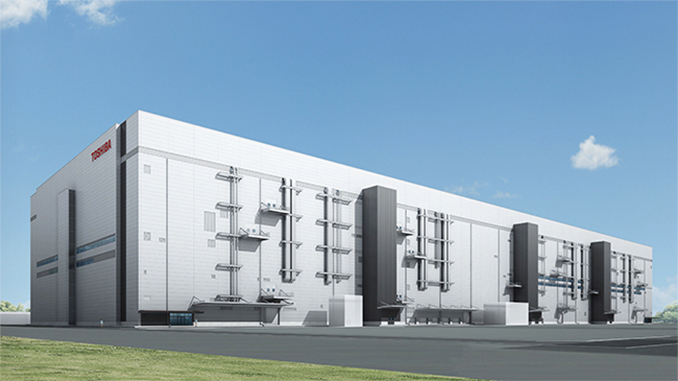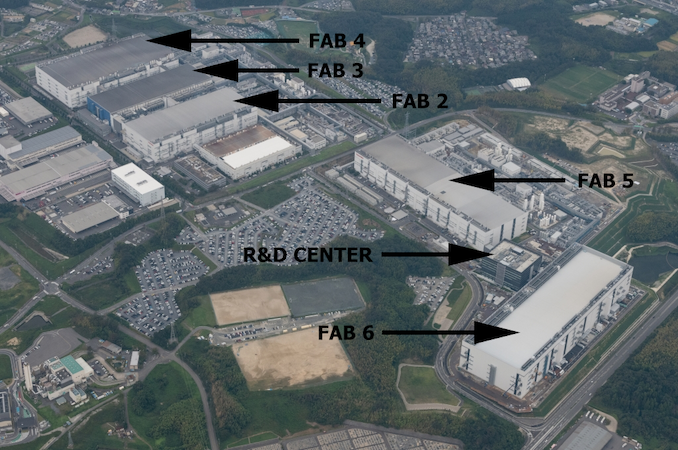Toshiba & WD NAND Production Hit By Power Outage: 6 Exabytes Lost
by Anton Shilov on June 28, 2019 12:15 PM EST
Toshiba Memory and Western Digital on Friday disclosed that an unexpected power outage in the Yokkaichi province in Japan on June 15 affected the manufacturing facilities that are jointly operated. Right now, production facilities are partially halted and they are expected to resume operations only by mid-July.
Western Digital says that the 13-minute power outage impacted wafers that were processed, the facilities, and production equipment. The company indicates that the incident will reduce its NAND flash wafer supply in Q3 by approximately 6 EB (exabytes), which is believed to be about a half of the company’s quarterly supply of NAND. Toshiba does not disclose the impact the outage will have on its NAND wafer supply in the coming months, but confirms that the fabs are partially suspended at the moment. Keeping in mind that Toshiba generally uses more capacity of the fabs than WD, the impact on its supply could be significantly higher than 6 EB with some estimating that it could be as high as ~9 EB.
Both companies are assessing the damage at the moment, so the financial harm of the incident is unclear. Not even counting potential damage to production tools and other equipment used at the fabs, 6 EB of NAND cost a lot of money. Furthermore, analysts from TrendForce believe that a consequence of the outage will be some loss of confidence from clients of both companies, which will have a financial impact as well.
The Yokkaichi Operations campus jointly owned and run by Toshiba and Western Digital produces about 35% of the global NAND output in terms of revenue, according to TrendForce. At present, the manufacturing base has five production facilities (Fab 2, Fab 3, Fab 4, Fab 5, and Fab 6) as well as an R&D center, all of which were affected by the outage. Three fabs within the campus produce 3D NAND flash, whereas another two are used to make special-purpose types of memory.
Considering the gargantuan size of the Yokkaichi Operations, disruptions of its supply will inevitably have an effect on 2D NAND and 3D NAND spot prices in the short-term future. Nonetheless, since contract prices have already been set for Q3 (and possibly Q4), they are not going to change. Meanwhile, it remains to be seen whether large customers will have to go shopping in Q3 or Q4 and affect prices on the spot markets further.
Considering that the Yokkaichi Operations produces at least 1/3 of the global NAND flash output (let’s assume that dollar share more or less corresponds to bit share) and half of its production for the quarter was lost because of the incident, this means that the industry will miss approximately 1/6 (or 16.5%) of the global NAND supply in Q3. Whether or not this will create a deficit on the market that will cause significant price hikes depends on multiple factors and is something that remains to be seen.
Related Reading
- Toshiba Memory and Western Digital Open Fab 6 and New Memory R&D Center
- Toshiba Memory & Western Digital Finalize Fab K1 Investment Agreement
- Toshiba Begins to Construct New BiCS 3D NAND Fab in Iwate Prefecture
- Toshiba Memory to Build New Fab to Produce BiCS 3D NAND
- Toshiba Finalizes Plans for New 3D NAND Fab: Coming Online in 2019
- Toshiba to Build New Fab to Produce BiCS NAND Flash
Sources: Western Digital, Reuters, TrendForce, Blocks & Files












148 Comments
View All Comments
PVG - Saturday, June 29, 2019 - link
sigh... And that's how you get an excuse to rise NAND prices all over again...Eliadbu - Saturday, June 29, 2019 - link
even if the prices will rise, you do understand that both of those companies will loseBillions of USD, as part of damaged goods, damaged machinery, losing major clients and contract
and more. for those companies this is NOT an excuse but more of a Nightmare coming to materialization.
FunBunny2 - Sunday, June 30, 2019 - link
"for those companies this is NOT an excuse but more of a Nightmare coming to materialization. "well, that assumes there is sufficient slack in current production elsewhere to fulfill the lost qtrly. production. IOW, the rest of the supply market has to have boatloads of unspoken-for production in process. near zero likelihood. it does take a qtr., apparently, end-to-end to get a chip out. depending on how long it takes to re-start the lines, what are the odds that other producers increasing production without firm contracts for product? near zero, yes?
and so on. lots of timing issues have to be answered w/resp. to how much production comes from others and how much moolah T/WD get from insurance.
evernessince - Tuesday, July 2, 2019 - link
It is nowhere near a billion in looses, let alone billions. Do the math, NAND sells to consumers at 0.10 / GB let alone what manufacturers pay. No equipment was damaged.SlashZerov - Saturday, June 29, 2019 - link
I worked at one of the largest datacenters in the world and its power draw would have been significantly more than the fabs in this article. In addition to direct connections to two different power stations we had batteries capable of keeping the power online long enough for our diesel generators which had a week supply of diesel and contracts with separate companies to do refills if needed. There are only two ways a loss like this could have happened. 1. They bribed a power company and sabotaged their own backup systems hoping to collect on insurance or 2. The executives were so totally incompetent they spent no money on proper disaster planning and should all lose their jobs.Anyone who thinks 1. Isn’t possible should google “Enron California power fraud”
GreenReaper - Sunday, June 30, 2019 - link
Let's be honest, 2) is just as possible - but of course "should" doesn't mean "will".FunBunny2 - Sunday, June 30, 2019 - link
"2) is just as possible"once again, with fervor: 1) what was/is the estimated probability of a 13 minute power outage and 2) what is the cost of building out a local power station (and maintaining its capability to power up and be on line fast enough to avoid loss of X% of in-process product) robust enough to run all of the campus for at least that long? I agree it's most likely no one ran the numbers for that scenario, since the back of the bar nap arithmetic made it way to costly.
no CxO is ever going to say, "I don't care what it costs, just give me a 1,000 (or X) megawatt power station that will go on-line in 10 milliseconds!!!!"
Threska - Sunday, June 30, 2019 - link
A little more to it than that. What is the results of a data-center going down, and how much would that cost? Same question applied to a semiconductor plant? Some might say the former is more forgiving, while the one's who did the final result agreed differently. i.e data-center loses more.Gunbuster - Wednesday, July 3, 2019 - link
No way on earth a data center looses more. A really good DC would be active-active with another geo separate facility and experience zero loss. A step down you restore power and pull in your near realtime backups from a NVME storage array and be back up in a hours to a day with some database headaches. In any case no one with even a quarter of a brain would go near a data center if they got told "well backup power generation is just too hard and costly at our scale. If we loose commercial feeds we'll run on UPS for 10 minutes or so and then your compute load goes poof gone."benzosaurus - Saturday, June 29, 2019 - link
Surprised it took this long, what with flash prices being low and all.